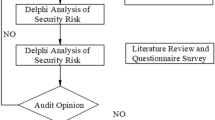Abstract
At present, the oil and gas SCADA system is facing severe information security threats, and the information security assessment for the existing SCADA system is an important response measure. In order to solve the problem that the standard of information security assessment of industrial control system are not perfect and the evaluation objects are fuzzy, this study put forward a novel method of oil and gas SCADA security assessment based on causality analysis. Firstly, defense security assessment technology route with pre-defense,post-defense was introduced and the evaluation indexes were mapped to the pre-defense and post-defense factors, and the pre-defense and post-defense scoring tables for oil and gas SCADA system information security were developed, the evaluation factors were formed as causality diagram table; then the factor space theory was used to evaluate and model the information security of oil and gas SCADA system, and the model was formally described. Finally causality analysis evaluation method of fuzzy Mamdani reasoning was adopted to evaluate factors neurons in the proposed model. The results show that the average accuracy of the causality analysis and the decision tree algorithm is 92.06 and 91.45% respectively. The causality analysis method based on factor space has a good effect on SCADA information security assessment. The conclusions of this study can not only be applied to oil and gas SCADA security risk assessment, but also provide a reference for other industry security assessment.










Similar content being viewed by others
References
Knapp, Eric D.: Industrial Network Security: securing critical infrastructure networks for smart grid, SCADA and other industrial control system [M]., pp. 30–152. Elsevier Inc, Waltham (2014)
Zhao, H.: Research on anomaly detection algorithm for industrial control systems[D]. Autom. Rese. Des. Inst. Metall. Ind., pp. 9–10 (2014)
Office of Electricity Delivery and Energy Reliability, US Department of Energy. NSTB fact sheet, national SCADA test bed, enhancing control systems security in the energy sector [Z/OL]. (2012-06-16). http://www.inl.gov/scada/factsheets/d/nstb.pdf
US-CERT.ICS-CERT[Z/OL].(2012-06-20). http://www.us-cert.gov/control_system
Commission of the European Communities. Communication from the Commissionto the Council and the European Parliament: Critical Infrastructure Protection in the Fight Against Terrorism, COM(2004)702 Final. Commission of the European Communities, Brussels (2004)
Commission of the European Communities: Communication from the Commission on a European Programme for Critical Infrastructure Protection, COM(2006) 786 Final. Commission of the European Communities, Brussels (2006)
Commission of the European Communities, Communication from the Commission to the European Parliament, the Council: The European Economic and Social Committee and the Committee of the Regions-on Critical Information Infrastructure Protection, COM(2009)149 Final. Commission of the European Communities, Brussels (2009)
Commission of the European Communities, Communication from the Commission to the European Parliament, the Council: The European Economic and Social Committee and the Committee of the Regions-A Digital Agenda for Europe, COM(2010)245. Commission of the European Communities, Brussels (2010)
The European Network and Information Security Agency (ENISA) Protecting Industrial Control Systems: Recommendations for Europe and Member States. Recommendations for Europe and Member States, Heraklion (2011)
Anderson, J.P.: Computer Security Threat Monitoring and Surveillance [R]. Fort Washington, Pennsylvania (1980)
Li, Y., Cao, X., Li, J.: A new cyber security risk evaluation method for oil and gas SCADA based on factor state space. Chaos Solitons Fract. 89, 203–209 (2015)
Yu, Y., Lin, W.-M.: Study on industrial control SCADA system’s information security protection system. Netinfo Secur. 5, 74–77 (2012)
Wu, Y.: SCADA system information security technology. Autom. Panor. 2013(2), 98–100 (2013)
Meng, C.J.: Research on Dynamic and Static Risk Assessment for Power Information System. East China University of Science And Technology, Shanghai (2015)
Wang, Y.: Study on Theories and Application of Industrial Control System Security Assessment. Chongqing University, Chongqing (2014)
Li, hongxing: Factor spaces and mathematical frame of knowledge representation(I)-axiomatic definition of factor spaces and description frames. J. Beijing Norm. Univ 32(4), 470–475 (1996)
Wang, H.-D., Guo, S.-Z.: Feedback extension-enveloping in factor spaces and its improvements. Fuzzy Syst. Math. 29(1), 83–90 (2015)
Ling, W., Geng, H., Xie, Y.: Framework for factor description of product performance. J. Comput. Aided Des. Comput. Gr. 15(2), 144–149 (2003)
Wang, P.: Factor space and description of concepts. J. Softw. 3(1), 30–40 (1992)
Hongxing, L.: Factor spaces and mathematical frame of knowledge representation(XI)-basic concepts of factor spaces canes. Fuzzy Syst. Math. 11(1), 1–9 (1997)
Yang, Li, Geng, Xinyu, Cao, X.: A novel knowledge representation model based on factor state space. Opt. Int. J. Light Electron Opt. 127(12), 5141–5147 (2016)
Wang, P., Guo, S., Bao, Y., et al.: Causality analysis in factor space. J. Liaoning Tech. Univ. 33(7), 865–870 (2014)
Ganter, B., Wille, R.: Formal Concept Analysis. Springer, Berlin (1999)
Liu, H., Guo, S.: Reasoning model of causality analysis. J. Liaoning Tech. Univ. 34(1), 124–128 (2015)
Zhang, R., Wang, S., Li, J.: Research on landslide susceptibility based on Mamdani-FIS model. Rock Soil Mech. 35(S2), 437–444 (2014)
Bao, Y., Ru, H., Jin, S.: A new algorithm of knowledge mining in factor space. J. Liaoning Tech. Univ. 33(8), 1141–1144 (2014)
Yang, J., Zhang, N.N., Jian, L.I., et al.: Research and application of decision tree algorithm [J]. Comput. Technol. Dev. 2, 031 (2010)
Kong, Y., Jing, M.: Research of the classification mehtod based on confusion matrixes and ensemble learning. Comput. Eng. Sci. 34(6), 111–117 (2012)
Yang, L., Geng, X., Liao, H.: A web sentiment analysis method on fuzzy clustering for mobile social media users. Eurasip J. Wirel. Commun. Netw. 2016(1), 1–13 (2016)
Author information
Authors and Affiliations
Corresponding author
Rights and permissions
About this article
Cite this article
Yang, L., Cao, X. & Geng, X. A novel intelligent assessment method for SCADA information security risk based on causality analysis. Cluster Comput 22 (Suppl 3), 5491–5503 (2019). https://doi.org/10.1007/s10586-017-1315-4
Received:
Revised:
Accepted:
Published:
Issue Date:
DOI: https://doi.org/10.1007/s10586-017-1315-4




